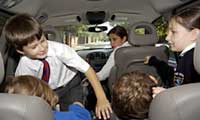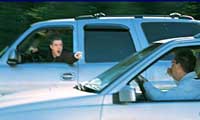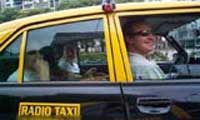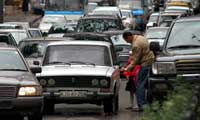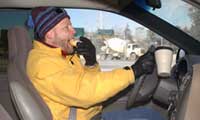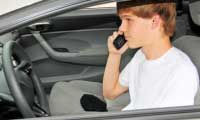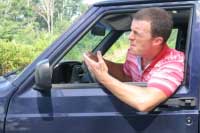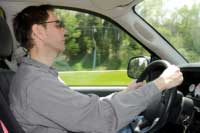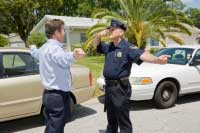Riding Around in an Automobile
The automobile is one of the most popular ways to get around. There are more than 600 million cars in the world and that number continues to increase. Cars have long been accessible for most people in developed countries. But in places such as India and China, the growth of the economy since the late 1990s has permitted more families to afford their own automobiles.
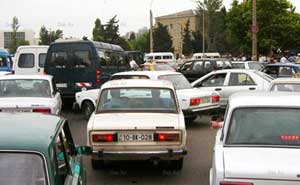 |
Photo courtesy of Nigar Sadigova It takes an experienced driver to understand traffic patterns in big cities, as seen here at this intersection in Baku, Azerbaijan. Cars, vans, and trucks are coming in from all directions. |
With all these cars on the road, chances are you travel in one regularly, either with your family or possibly with friends. You may even be approaching the age where you can get a driver’s license. Thus it is very important to know how to be a good passenger and a safe driver.
Safe Passengers
The driver may be the person in control of the car, but the passenger has important safety responsibilities. Remember, if something happens to the car, the passenger is as much affected as the driver. In fact, studies show that the behavior of passengers has a significant effect on the behavior of the driver. In the United States, some states have laws restricting teenage drivers from having passengers with them, other than adult family members or older experienced drivers, for the first year after receiving a driver’s license.
|
A distracted driver cannot focus properly on the road. Passengers must stay in their seats and not fool around with each other, as these children are doing. |
Aggressive driving, including speeding, traveling too close to the vehicle directly ahead (known as tailgating), and yelling at other drivers, is a leading cause of collisions. |
|
|
Passengers often forget to use the safety belt when riding in a taxi. |
The middle of the road is not the safest location for dropping off or picking up passengers. Other drivers may not see what is going on until they are too close to the stopped vehicle. |
Most important, passengers must wear their three-point seat belts (lap belt and across-the-shoulder harness), whether they are in the front sear or the back seat. This type of seat belt prevents some of the more severe injuries in the event of a collision. It does this by stopping the motion of the person wearing the restraint. When a car comes to a stop abruptly, the people (and objects) inside the car keep moving until they hit something that is not moving. This continued motion of a person once a car stops often causes injuries, because an unrestrained person can hit any of the hard surfaces—such as windows, doors, or dashboard—or other people in the car. A person not wearing a seat belt can even be thrown from the car, through a window or windshield. This type of event causes extensive injuries.
The seat-belt rule applies to all car trips and all seats in the car. People often think that if they are just going out for a brief trip, they don’t need to wear their seat belts. Statistics show that accidents are more likely to happen close to home than at a distance. In fact, collisions are twice as likely to occur within 1.6 km (1 mi) of home as they are 32 km (20 mi) from home. Many people don’t bother to put on their belts when they sit in the rear. And although the backseat is generally safer than the front seat, a seat belt is needed there at all times as well.
While riding in a car is fun, driving is serious business and requires concentration and attention. A passenger must not distract the driver. The driver has to focus on the road, and he or she should not have to pay attention to what is going on in the vehicle. Many behaviors can be distracting. These include touching the driver or fooling around in the car, having upsetting conversations or saying things that will provoke an emotional response, playing the radio loud, making a lot of noise, having loud cell phone conversations, and telling the driver to look at things outside the car. If traffic conditions are stressful, or the driver is trying to locate an unfamiliar place, he or she particularly needs to concentrate.
Sometimes, though, the passenger can be an extra pair of eyes for the driver. A car has blind spots—places that do not show in the mirrors and can be seen only by turning one’s head. The passenger can look out for things the driver needs to know—for example, a hole in the road on the passenger side, or a barely visible pedestrian. The passenger must be careful not to be too helpful, however, because too many pointers can be annoying and even distracting.
 |
Digging Deeper |
At times the passenger must look out for everyone’s safety. Aggressive behavior, such as passing other drivers too closely or racing with other vehicles, must be discouraged.
A passenger must refuse to ride with anyone who is drunk or on drugs. In addition, the passenger should do everything in his or her power to prevent an impaired driver from getting behind the wheel.
There’s much a passenger can do to make the trip safe: answer cell-phone calls, discourage aggressive behavior, and make sure everyone has their seat belts on. And if the driver is obviously too tired to be at the wheel, insist on stopping. In these ways, the passenger can ensure that everyone in the auto has a safe trip.
Safe Drivers
|
More and more places are making hand-held cell phone use illegal while driving. The driver is distracted and does not have both hands on the steering wheel. The passenger, who is applying make-up, is also distracted. |
Eating while behind the wheel, although common, is not a safe behavior for drivers. Dropped food or a spill can cause the driver to take his or her eyes off the road. |
|
|
The rear window of an auto should be clear of objects, to allow the driver to see behind. |
Use of a hand-held cell phone has been cited as a factor in many collisions. |
After years of being a passenger, you are set to be the driver. You’ve passed your driving test and now have your driver’s license. The road beckons. And it’s an exciting prospect, isn’t it? Going fast is exhilarating! But driving is serious business, especially for new drivers. Their lack of experience makes them the most likely to get involved in a collision. So let’s take a look at driving basics. The most important goal for a driver is to get to wherever he or she is going without hitting anything.
The driver must know and obey the rules of the road. This means observing speed limits and obeying traffic signals and signs, even if there are no other cars on the road. These rules are not arbitary. If everyone follows the rules of the road, the roads will be safer.
One of the most basic rules of the road is to wear seat belts. The importance of the seat belt cannot be stressed enough. The seat belt prevents many injuries in case of an accident, and it can even keep a driver stable enough to maneuver out of a bad situation.
Once a driver is out on the road, he or she must be alert to what is going on around the car. The more attention a driver pays to the road, the quicker the reaction to a surprise, such as another car that is not following the rules of the road. A driver needs to be aware of all the traffic on the road. He or she can do this by using the car’s side-view and rearview mirrors to see what is going on. A driver must also be as aware as possible of other travelers on the road, including pedestrians, bicyclists, motorcyclists, and in some places carts and wagons and animals.
 |
Digging Deeper |
One thing drivers need to watch is the distance needed to brake safely, without hitting the car in front. Driving too close to the car in front, called tailgating, can cause a collision if the car in front stops or slows down suddenly. It takes a certain amount of distance to stop safely, and the faster the speed of the car, the greater the distance needed to stop.
Part of being alert is avoiding distractions. Distractions take the driver’s eyes, ears, and overall attention off the road. A driver can create distractions by changing the music that is playing, talking on a cell phone, or eating. These seem minor, but they take a driver’s concentration from the road. Even more serious problems occur when drivers attempt to do things that cause them to take their eyes off the road, such as reading and text messaging. Passengers who are not behaving properly can also be a dangerous distraction.
|
Photo courtesy of FreeFoto.com A driver must be extra vigilant during bad weather. Poor weather conditions, as may occur during a snowstorm, make for poor road conditions. Speeding and other forms of aggressive driving can be extra dangerous on bad roads. |
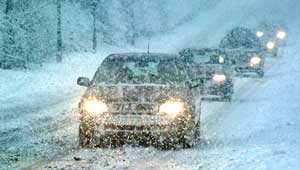 |
Road conditions, especially those due to cold or wet weather, are a factor a driver cannot control. However, drivers can drive for the road conditions, by proceeding with caution. If the roads are slippery with rain, slick with mud, icy from snow, or clouded by fog, drivers need to go slowly and to factor the conditions into their driving decisions.
A driver must keep his or her vehicle well maintained, making sure that all lights and signals work properly. This is important so that other drivers can be aware of what he or she is doing. In addition, a driver needs to have tires and brakes checked and replaced if worn.
One more important factor: the driver’s behavior. Drivers should not race other cars, or indulge in road rage at the behavior of the other drivers. Many drivers try to reach their destination no matter how tired they feel. But a drowsy driver is one who is not alert. Tired drivers should find a place to pull to the side of the road and take a nap, or at least take a break.
|
Road rage—yelling at drivers and other types of aggressive behavior—is another type of distraction that can cause collisions. |
Sleepy drivers are dangerous drivers. A tired driver should find a place to take a break or a short nap. |
|
|
Driving under the influence of alcohol or drugs is extremely dangerous. A driver’s judgement and reaction time is significantly impaired. Police officers who suspect that a driver is impaired can perform field sobriety tests. |
Impaired drivers can severely injure themselves as well as their passengers, other drivers, and pedestrians. |
Most important, a driver must be sober when he or she gets behind the wheel of a vehicle. Many collisions occur when a driver is under the influence of alcohol or drugs. Driving while under the influence of alcohol or drugs is not only dangerous, it is illegal. It can have very tragic consequences.
 |
Digging Deeper |
This content has been re-published with permission from SEED. Copyright © 2025 Schlumberger Excellence in Education Development (SEED), Inc.


